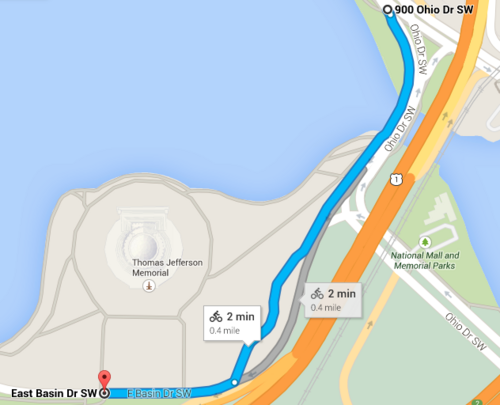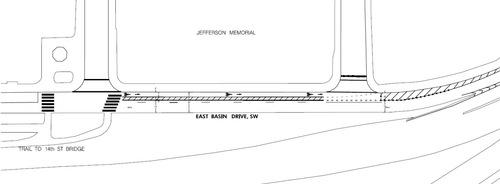A temporary fix could make Cherry Blossom Festival traffic safer
Each spring, thousands of visitors flock to the Tidal Basin during the Cherry Blossom Festival. The crowds make it hard for bike commuters using the 14th Street Bridge path to get into the District. Temporary changes to the street and sidewalks could ease the problem.

Looking northeast along East Basin Drive. The Jefferson Memorial is to the left. All photos by the author.
When someone rides into DC from Virginia on the 14th Street Bridge, they take the sidewalk on East Basin Drive to get from the bridge exit to Maine Avenue. This is because East Basin is one-way southbound from where it splits from Ohio Drive.

The stretch from the 14th Street Bridge to Maine Avenue, a short .4 miles, is a common route into DC. Image from Google Maps.
During the festival, there are pedestrians all over the sidewalk. Tour buses, taxis and even the DC Circulator-operated Haines Point Shuttle use the East Basin Drive sidewalk for loading and unloading behind the Jefferson Memorial.
This forces cyclists coming off the bridge to either ride against traffic on the street or through throngs of pedestrians on the sidewalk. Neither is a safe option.
This is an especially big problem because the festival coincides with an upswing in temperatures and, with that, bike commuters. In all of March, an average of 873 cyclists used the 14th Street Bridge to cross the river on weekdays. But on days when temperatures rose above 50 degrees, the average number of cyclists rose with them, to 1,101.
Despite the clear conflict, the National Park Service (NPS), which controls the roads around the Tidal Basin, has no plans to accommodate bike commuters along East Basin Drive during this year’s festival.
“While we have taken some measures for bicyclists attending the festival, including providing bike tours of the blossoms and extra bike parking at the Jefferson Memorial, we are not implementing any new dedicated bike lanes or restricting pedestrian access along Maine Avenue, or any other streets,” says Mike Litterst, a spokesperson for NPS.
A temporary protected bike lane could work here
One way to fix the problem could be a temporary, contraflow bike lane that separated people on bike from people on foot.
The lane could start on the south side of East Basin Drive, at the entrance to the 14th Street Bridge. After only 330 feet, it could put cyclists onto the sidewalk that runs along Ohio Drive on the way to Maine Avenue. The sidewalk is big, so blocking off a portion off for bikes won’t necessitate inconveniencing pedestrians.

A temporary protected bike lane could run along this section of East Basin Drive, roughly where the cyclist is in the photo.
While it’d be ideal to keep cyclists off the sidewalk altogether, doing so isn’t feasible because East Basin narrows to one lane for a short section when it meets the bridge.
This temporary fix could lead to a longer-term solution
A temporary protected lane during the Cherry Blossom Festival could be a good way for NPS to test this much-needed improvement to Washington DC’s cycling infrastructure.
DDOT is considering plans for a permanent protected bike lane that would run counter to traffic on East Basin Drive in order to serve cyclists coming off the bridge.
Temporary protected bike lanes are increasingly common. Last year, Streetsblog USA profiled nine of them in cities that included Atlanta, Lawrence, Kansas, and Oakland.
They are also easy to put in. The lanes Streetsblog looked at used a mix of traffic cones, temporary planter boxes, old tires, and chalk to separate bikes from car traffic.
Here’s a video from STREETFILMS about a bike lane that went up for a week in Pittsburgh:

